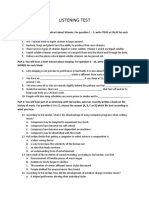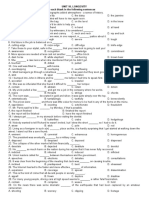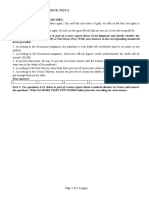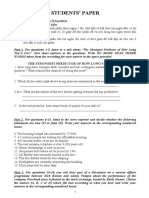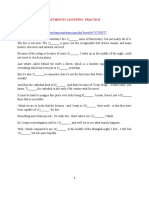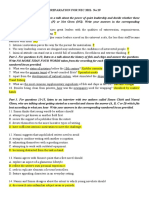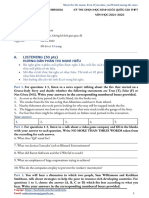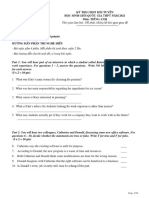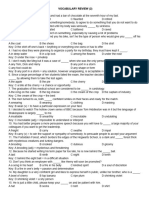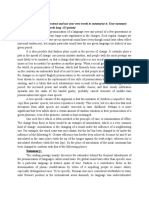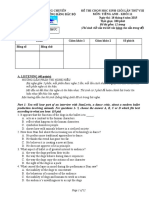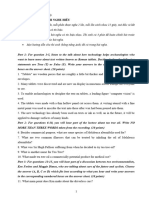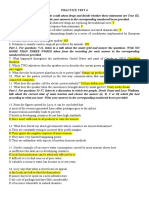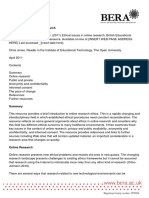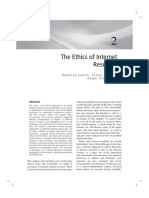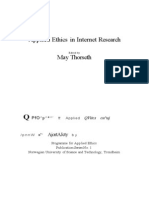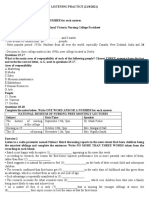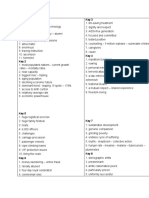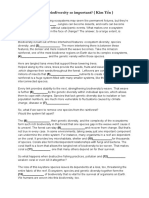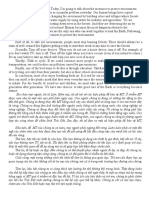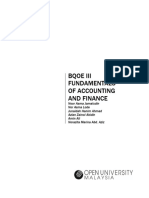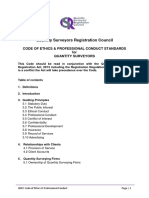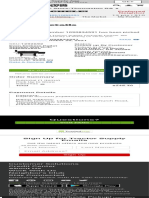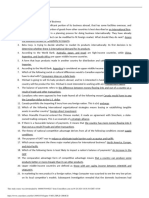READING PRACTICE: MULTIPLE CHOICE
Exercise 1
The Ethics of Online Research
In addition to the argument for restraint in reporting research online, there
has been considerable discussion of the need to adopt a judicious approach to
collecting data online. The very accessibility of data on the Internet relating to
every social phenomenon and social problem imaginable has led some
commentators to fear that researchers could be tempted to use it as a research
playground, scooping up interesting data without due regard for the concerns of the
people involved. There has been a particular debate around the circumstances in
which informed consent applies to the use of data collected via the Internet.
The emerging position of the ethics of using Internet research data is not
dear-cut. As in any form of research, those using Internet data are expected to be
sensitive to the possible concerns of research participants and develop appropriate
responses to each situation. The Association of Internet Researchers has published
a code of practice for research using the Internet, which consists of questions for
researchers to ask themselves rather than specific guidance on forms of data that
can and cannot be used. The questions are, however, based on the premise that the
ethics of Internet research are remarkably similar to the ethics of any other research
approach. Internet researchers are expected to adopt a 'bottom line' position that
foreseeable harm to research participants should be prevented and that deceit of
any participant is rarely justifiable.
There are circumstances where informed consent may not be appropriate. If
a researcher can be confident that no foreseeable harm could accrue to people from
the use of publicly available data such as a website or a contribution to a discussion
forum, that the topic is not particularly intrusive or troubling were the person to
recognise themselves in a research report, then it might be justifiable to go ahead
and collect data without seeking informed consent. In many cases, however,
approaching someone for their consent to use data is more appropriate, and it can
actually be a useful part of the research process and lead to interesting insights that
help in interpreting the data.
If the research focuses on a chat room, it may be simply impractical to gain
informed consent from everyone involved since this would interrupt the flow of
chat and as people leave and join the chat room, it would be unclear exactly who
had consented to what. In such circumstances, it has been suggested that it may be
necessary to adapt the research to involve a specially set-up chat room that is
obviously a research site to all participant
Alternatively, it may be appropriate to apply for a waiver of informed
consent requirements on the basis that the research poses no threat to participants.
Most researchers will need to apply for ethical approval of their research to an
institutional committee or funding body: it will be necessary to develop a careful
statement about the reasons why an informed consent waiver is appropriate for a
particular case.
Where informed consent is required, the practicalities again vary. Often if
interviewees are being contacted by email, it will be appropriate to send them an
initial statement explaining the research process and the confidentiality of the data,
informing them of any potential risks of participating and giving contact details for
the researcher. Interviewees may be asked to "opt in' to the research by stating that
they have read and accept this statement. Rarely is it felt that interviewees need to
print out and return a signed copy of a consent form, although this may be regarded
as sound practice if the research topic is particularly sensitive or if minors are
involved. Individual consent of this kind may be impractical for studies of chat
rooms, and it may be necessary to rely on the agreement of chat room moderators
and an announcement when people join the chat room. Similarly, when a
�discussion forum is being observed, it may be necessary to gain the consent of the
forum owners and to post announcements periodically about the on-going research
to the forum itself. In addition, researchers would be expected to make their
identity clear in any interactions they might have in the forum.
1 The writer's use of the phrase 'scooping up'
reflects
A the volume and availability of online research
data.
B the novelty value of conducting research on the Internet.
C the proliferation of social networking sites.
D the exponential rise in the popularity of the web.
2 When online research data are gathered,
A it becomes more difficult to distinguish between valid and invalid premises.
B there is more chance of researchers avoiding moral issues.
C a questionnaire must be completed by the person conducting the study.
D the onus is on the researcher to maintain ethical integrity.
3 One advantage of asking for consent from participants in online research
is that
A particularly sensitive individuals are bound to be more receptive.
B it gives the research topic extra credibility.
C it can provide the researcher with more than superficial information.
D the study will be considered more relevant to the context.
4 Online research carried out in a specially set-up chat room
A makes the chat unreliable as participant behaviour changes.
B removes the need for ethical issues to be taker into account.
C allows the sociologist to use all the data gathered.
D is particularly suitable for obtaining information about institutions.
5 A researcher may consider it prudent to get a hard, signed copy of a consent
form when
A participants feel uncomfortable about giving permission online.
B the research relates directly to juveniles.
C the forum under examination raises controversial issues.
D communication by electronic means proves impossible.
6 The purpose of the extract is to make the reader aware of the need to
approach online research with a degree of
A. trepidation
B. caution.
C. scepticism.
D. empathy.
Exercise 2
Consumerism and Advertising
The creation of the consumer culture can be traced back to the role of early
twentieth-century advertising. Turn-of-the-century capitalists and captains of
industry saw mass advertising as a way of shaping the consciousness of the
American population in a way that would give legitimacy and stability to the
rapidly industrialising society. The key to this new consciousness was the creation
of a new way of life based on the pleasures of consumption. Mass advertising
emerged in the 1920s, when leaders of the business community began to see the
need for a coordinated ideological effort to complement their control of the
workplace. Advertising would become the centrepiece of a policy to sell not only
products but also a new American way of life in which consumption erased
differences, integrated immigrants into mainstream American life and made buying
the equivalent of voting as a form of commitment to the democratic process.
From the beginning, then, advertising was more about creating consumers
�than selling individual products. If a mass production economy was to be profitable
and if those who worked long hours under difficult conditions were to be pacified,
new needs and habits had to be stimulated. This was the job of advertising. Its
early practitioners built on people's insecurities to shape desires for new consumer
products. Solutions to personal problems were to be found in the world of
consumption, an early version of the currently prevalent attitude that views a day
of shopping as a way to cheer oneself up. Ads suggested that new products such as
mouthwash and deodorant would protect people from embarrassment and give
them a ticket to the modern world. Old habits and traditions that recent immigrants
brought to the United States were to be discarded in favour of the new 'American
way', participation in a consumer society. Ads sold consumerism as a gateway to
social integration in twentieth-century America that would serve as a form of social
cement.
One way advertising tried to sell a cross-class ideology of consumerism was
through its focus on the realm of consumption and its neglect of production. The
industrial workplace might be degrading, but advertising offered a world that was
far removed from the drudgery of work, emphasising the wonders of the consumer
lifestyle. It was, after all, the dream of a specific lifestyle and associated world
view that ads were selling, regardless of whether people had the means to really
live it.
One modern medium that is particularly advertising-oriented and
consistently promotes the ideology of consumerism is the 'women's magazine'.
These magazines promote the consumer lifestyle by showing how beauty,
desirability, career success, culinary skill and social status can be bought in the
consumer marketplace. Social problems, from the standpoint of consumer
ideology, are redefined as personal problems that can be solved by purchasing the
appropriate product. Women's magazines, in addressing a specific social group,
identify women as a consumption category with special product needs. The
magazines link an identity as a woman with a set of specific consumer behaviours,
making the latter a prerequisite for the former. To be a 'woman', then, is to know
what to buy; the ad content in women's magazines both displays the specific
products and celebrates the pleasures and needs of consumption. But there is more
to women's magazines than just the ads. Even though a common reading strategy is
to leaf through the pages, casually glancing at the ads and headlines, pausing to
read non-advertising articles reveals that they are a form of 'covert advertising' that
promotes the same kind of consumer-oriented ideology.
Even the 'editorial advice' provided by women's magazines is a form of
covert advertisement, selling the consumer ideology. Beauty advice, for example,
routinely suggests the consumption of various forms of makeup as a way to
achieve beauty. Such advice often identifies brand names that are most effective
brands frequently promoted in ads in the same magazine. The ubiquitous
'makeover' feature, in which an 'average' woman is turned into a glamorous model
look- alike is, in essence, an endorsement of the beauty products advertised
elsewhere in the magazine. Advice, then, really concerns appropriate consumption
habits. Just as early as identified newfound needs, the women's magazine suggests
what women need. In the end, women's magazines use both direct and covert
advertising to sell magazines and promote an ideology that celebrates the
consumption of gender-specific products as a means to identity formation and
personal satisfaction - the dream of the 'good life'.
7 At the beginning of the twentieth century, capitalists regarded mass
advertising as
A a tool for satisfying the desire to belong to a consumer culture.
B a tactic to persuade voters to give them political power.
C a means of changing attitudes so that industrialisation would seem justifiable.
�D a vehicle that would allow the general population to identify their needs.
8 One of the earliest mass advertisers' main goals was to
A force all consumers to reject their previous habits and beliefs.
B inform the public that consumerism results in greater happiness.
C help people analyse the causes of their problems.
D heighten awareness of how quickly the world could change.
9 In twentieth-century America, advertising offered the less well-off members
of society
A promises of wealth.
B illusions of grandeur.
C improved career prospects.
D a means of escapism.
10 The content and advertising in women's magazines are designed
around
A the reader's desire to appear feminine.
B the spending habits associated with women.
C a woman's ability to adopt creative solutions.
D the exclusively female need to be kept happy.
11 A part of women's magazines is devoted to
A advising readers to purchase the most expensive products available.
B persuading women that having flaws should not cause embarrassment.
C promoting the idea that being beautiful inevitably leads to success.
D supporting the claims made by advertisers.
12 It might be concluded from the extract that advertising is a force for good
because it can
A prevent people from falling into despair.
B help in the struggle against social inequality.
C improve conditions in the industrial workplace.
D allow people to reach their full potential.
Exercise 3
The changing face of shopping
Strange as it may seem, consumer watchdogs are convinced that burgeoning
online shopping numbers will not result in the death of the High Street. Instead, it
will force an evolution in terms of the shopping experience.
It is becoming increasingly clear that the under 40s rely on the existence and
security of a retail outlet if only for somewhere to check the item they want to buy.
However, frequently, their spot of research may ultimately lead to an online
transaction when it comes to the actual purchase. It is common practice for the
consumer to enter a store to get a physical idea of their intended purchase, use their
phone to compare the store price of their prospective purchase with those found
online, and then opt for the best price available.
The phenomenon has been dubbed ‘showrooming` and has led to many large
supermarket brands opening what's known as 'dark stores', which in turn are
creating thousands of new jobs. They're not designed for your typical shopper, in
fact they're ugly purpose-built warehouses that are never likely to see a real
shopper. They are merely there for the growing population of insatiable online
shoppers. Imagine an enormous supermarket with fully stocked shelves, no
customers, no garish advertising and no busy tillpoints. That pretty much sums
them up. They are populated by busy 'personal shoppers' filling up trolleys with
customer's orders; and the only face these retailers have is the driver who delivers
the shopping.
Dotcom food shopping is still in its infancy but is predicted to double in
value over the next five years to an enormous 12 billion. In fact technology-driven
consumer behaviour will generate growth across at least twenty different retail
�sectors resulting in an estimated 1.5 trillion in future sales by 2016. Clearly there is
money to be made in spite of the economic downturn in Europe.
When it comes to food, the need to see what you buy is not quite as great,
but especially within the clothing sector, most shoppers would rather have a
tangible idea of what they're spending their money on. Because so many
consumers are frequently connected to the Internet to research and analyse their
purchase either by price checking or through social shopping, retailers are faced
with the challenge of finding ways to make being connected part of the shopping
experience. Visualisation technologies are likely to feature much more heavily,
making it easier to actually see items. In the furniture sector, for example, people
will virtually place items in their homes and ensure that they suit as well as fit the
environment. Already it's possible to see mini videos of modelled clothing, and
technology packages will reflect this requirement by becoming faster and more
efficient processes for mobile devices.
Yet, if people want to go into bricks and mortar shops, technology does
dictate that "showrooming' is here to stay, which forces the high street retailer to
reassess the role of the store. For smaller stores it is likely to mean partnering up
with larger outlets to allow a greater flexibility in terms of pricing, but large
flagship stores are going to become more like brand cathedrals where, rather than
being places for purchasing, they will evolve into interesting areas for advertising
the product while customers are free to purchase online.
In truth, many big name designer retailers have already started doing just
this. With growing competition to draw people to their sites, they are developing
consumer concepts which go far beyond the mere displaying of product.
Architecture is key, as well as clever interior designing often coupled with
interesting design exhibits, so that the experience becomes artistically stimulating
while potentially encouraging a purchase, Rifling the racks is not enough and any
store has to offer something extra.
This will be a key consideration for town planners and developers if they
want to keep the average high street bricks and mortar shops open. Yes, their
physical existence is reassuring, but they are most definitely going to have to go
that extra mile to get numbers through their doors. shopping really isn't just about
the purchase anymore, its about an entire experience involving recreational options
and eating choices in addition to the retail element. A clever marriage of shop,
restaurant, museum, salon -and art gallery is going to be key. If it was the over 40's
only in the shops, the town centre as we know it would be dead. CBCDDD
13. What claim have consumer watchdogs made about the High Street?
A It has no future.
B It has little appeal for the younger generation.
C It will need to reinvent itself.
D It offers much to the online shopper.
14. Why are some consumers choosing not to purchase
in store?
A Because they are dissatisfied once they actually view the
items.
B Because they find more favourable deals elsewhere.
C Because there is no showroom.
D Because they are dissatisfied with the service.
15. According to the text, what is ‘showrooming’?
A visiting shops to see what is on offer
B showing off your purchases online
C making online price comparisons of store items
D shopping for products online
16. What is least likely to be driving the opening of 'dark
�stores'?
A The dramatic rise in online shopping.
B The need to cut supermarket
running costs. C The potential for
generating more revenue. D The need
to meet customer demands.
17. In what way might developments in visualisation technology hinder the
survival of bricks and mortar stores?
A. By reducing the need to visit stores
B. By increasing high street rental costs
C. By forcing more online transactions
D. By introducing a more attractive element to the shopping exercise.
18. What techniques have some retailers used to attract
customers?
A They have improved their advertising campaigns.
B They have evolved their product range.
C They have turned their stores into galleries.
D They have found ingenious ways to create cutting edge retail spaces.
Exercise 4
Tree Energy
Renewable energy is a key focus of most nations' energy programmes today,
and with countries like Portugal and Costa Rica leading the way in disproving
those naysayers who claimed that it would never be sufficiently reliable or
commercially viable to provide power on a grand scale, it has received even more
attention of late. As the level of interest peaks, innovative new ways of generating
renewable energy are also being explored. Of course, wind energy has been around
for a very long time now; however, researchers in Iowa have been examining it
from a different perspective outside the box of late and they may yet prove that it is
possible to reinvent the wheel, so to speak — or the turbine — after all.
Inspired by the rustle of the leaves in the trees on a casual stroll one day, it
occurred to one Iowan scientist called Eric Henderson that it might be possible to
harness low-to-ground wind energy in a way that traditional wind turbines simply
cannot, by replicating the conditions he observed. Indeed, the idea became
something of an obsession and he grappled with the notion for some time,
researching in-depth the shapes, dynamics and oscillations of tree leaves with the
help of two colleagues he recruited from his university. Together, they conceived of
the concept of a faux forest, where artificial trees replace woody ones and harness
the unexploited energy potential of low-level winds.
However, the concept proved far more complex in actuality than in
principle, demanding the application of very advanced physics. As their research
continued, the scientists encountered the expected obstacle of reliability; wind is
not, after all, guaranteed and weather conditions are highly inconsistent, To
maximise conversion rates, the scientists' faux trees would, therefore, have to
resemble their natural cousins. However, they also soon identified a phenomenon
known as parasitic capacitance as acting on the energy conveyed to the leaves. This
is something akin to a leech sucking the lifeblood out of its hapless victim because
while, in theory, wind-induced leave oscillation can generate a lot of energy, much
of this is lost through various parasitic effects, such as the leaves wiggling in
different directions.
Since the identification of this and other problems, researchers have worked
relentlessly to try to overcome them, but, though they have made tangible progress,
the road to commercial application is still a long one. However, just as they have
unearthed unforeseen complications, so, too, have they identified additional means
of harnessing energy from faux trees. For instance, another research group is
�looking to broaden the scope of exploitation and increase the capacitive potential
of faux trees by focusing on solar and heat energy as well as wind. The technology
and science is somewhat lagging at the moment, though, and until it catches up,
faux trees look set to remain little more than a novel concept for now.
Besides, question marks must remain for reasons other than practicality and
commercial viability, too; after all, the supposed attraction of renewable energy is
that it is cleaner and greener, yet this is another assertion that is heatedly debated.
For instance, wind turbines, while providing clean energy in one sense represent an
unacceptable visual blot on the landscape to many, particularly as they tend to be
most suited to placement in remote areas of natural beauty, necessitated by the fact
that wind speeds and conditions simply are not conducive elsewhere — remote
locations are, by default, very raw and wild. Additionally, the infrastructure
required to construct turbines can permanently alter the dynamics of the
surrounding natural habitat and ecosystem, particularly when transport systems
must be built. Indeed, nature itself must make way for this type of technology to be
erected and the impact on the local habitat can, therefore, be very significant.
Would forests of artificial trees, then, be any less invasive and damaging to the
natural world? Besides, it is doubtful even if so that they would be any less of an
eyesore.
19. What have researchers been doing recently according to the first
paragraph?
A showing that wind is a viable energy form
B proving people who criticise renewable energy wrong
C experimenting with different shapes of wind turbines
D exploring innovative new ways to harness wind energy
20. What is fundamentally different about Henderson's idea for harnessing
wind energy according to the second paragraph?
A it aims to use natural trees to replace traditional wind turbines
B it aims to use living trees to naturally harness energy
C it aims to exploit a source of wind energy turbines cannot
D it aims to exploit low-to-ground wind energy using traditional turbines
21. What unforeseen problem did the scientists encounter according to the
third paragraph?
A their faux trees could be infested by a parasite
B much of the potential wind energy generated is unusable
C their tree turbines would not look much like natural trees
D leeches would attack the tree leaves
22. What does the fourth paragraph suggest about the potential of tree
energy?
A scientists are close to solving the problems they have found
B future technological advances may make it more viable
C three viable means of exploitation now exist thanks to new technology
D little progress has been made on solving the problems identified
23. Why does the author discuss present wind energy systems in the last
paragraph?
A to illustrate problems tree energy could resolve
B to highlight the importance of such clean, renewable energy
C to highlight further issues with tree energy that will need
consideration
D to suggest that tree energy is superior to them
24. What can we infer is the author's position on tree energy?
A even if it becomes commercially viable questions still remain to be
answered
B it is only a matter of time before tree energy is widely used
�C it is highly unlikely tree energy will ever become commercially viable
D existing renewable energy sources are more environmentally
friendly
Exercise 5
True Love
Love is a force of nature as unpredictable and potent as a rising storm; when
it hits you, it sweeps you off your feet with such intensity that you can barely right
yourself and withstand its unrelenting power. It draws you with tornadic force
towards euphoria. Just a moment's eye contact is enough to fire your senses into a
blaze of passion. One glance and you know she is the one. Forever more, you will
devote yourself entirely to the otherworldly apparition of perfection that has
somehow materialised before you, selflessly and unconditionally committed to her
happiness. After all, could there be a purer cause? Now you are completely insane.
Forgive the intervention, but this love is an animal quite so rare as to be status
critical on the endangered species list. All credit to.Hollywood and its brethren for
fabricating and propagating this grand facetious notion, and my apologies for the
stereotypical gender depiction.
However, let's call a spade a spade; this is nothing other than a manifestation
of desire, or, to put it more kindly, attraction; a sensation which, of course, is not to
be dismissed, having both its merits and its part to play in the initial stages of
relationship development; however, the danger when we allow ourselves to be
duped by the Hollywood depiction of love is that the bar of our expectations is set
so high as to all but guarantee three faults and disqualification from the contest.
Perhaps it is useful to continue with the storm analogy a while, though, for what
follows this initial burst of passion and impulse may indeed be the blissful calm
and perfection of the eye of the tempest; however, the moment is but fleeting and
trailing the eye is a long tail that is arduous to navigate and endure.
Running with the storm analogy, the real storm here is not one in a teacup by
any means, though, because when we buy into the media's fairy-tale portrait of
love, we set ourselves off down the road to perpetual misery. If we believe that
when we find the one' our certitude will be so great as to produce an undeniable
sense of knowingness and bliss, then the moment doubts start to creep in or cracks
start to emerge in the relationship, we feel a diminished sense of compatibility with
our match and throw it all away before we've really even given it a chance to work.
Although the bitter taste of reality presented here so far might sound a touch
depressing to some, personally, I find the notion that true love is reached through
hard work — and not simply fate-bestowed —refreshing, and I am far from a blind
optimist. After all, it means we don't have to leave it to chance, which should give
us cause for hope. It means that if we encounter problems in our relationship, we
can take comfort in the notion that, when we are prepared to work through them,
there is light at the end of the tunnel. We are the masters of our fate.
Let me put it this way: if you pilot the love plane for long enough, you will
indubitably encounter storms and turbulence from time to time, and there is no
predicting when they may happen. However, the more often you fly and the more
familiar you become with your crew and the route, the more likely you will be able
to navigate through the problems safely, so the impact of the turbulence should
lessen over time. Furthermore, there will also be, guaranteed, pure heavenly
moments when the clouds disperse and you are soaring as through perfection.
These moments of magic make the challenges worthwhile. On the other hand, if
you press the ejector button prematurely, you will never know such experiences.
What's more, you might endanger yourself and you must surely abandon any other
persons on the plane. Note, though, that I said prematurely. Sadly in life, not
everything can work out as planned, but we must at least give it a fighting chance
and be sure we have done our best.
�25. What is the writer's main reason for using evocative( gợi lên nhiều c/xuc
mạnh mẽ) language in the first paragraph?
A to convey the intensity of the emotion of love
B to criticise the influence of the
media C to highlight the rarity of
true love
D to highlight a form of gender bias
26. Why does the writer use the example of a storm in the second paragraph?
A to show that initial attraction has no relatedness to love
B to highlight the dangers of acting on desire
C to imply that a lasting relationship is full of challenges
D to suggest that love is a temporary emotion
27. What does the writer mean when he refers to a storm in
a teacup?
A the effect the media has is very serious
B the media's influence should not be overestimated
C feelings of hurt do not last very long
D we make too much fuss about relationships
28. Why does the writer not find the sober view of love he depicts
discouraging?
A because love is a tottery anyway
B because he is optimistic by nature
C because it means we control our own
destiny D because we can learn from
failed relationships
29. What does the writer really mean when he talks about ejecting from the
plane prematurely?
A unless you work at a relationship, you wilt never experience the joys it can
bring
B it is more dangerous to leave a relationship than to try to work on it
C wait until things are calm and you have a clear head before making big decisions
D even when a relationship fails, it is not the end of the world
30. What best sums up the writer's thoughts on love and
relationships?
A he believes that even healthy relationships have their ups and
downs
B he believes that love is not a very realistic concept and people should settle for
less
C he is a true romantic who believes in love at first sight
D he is against people abandoning relationships in all but the most extreme
circumstances
